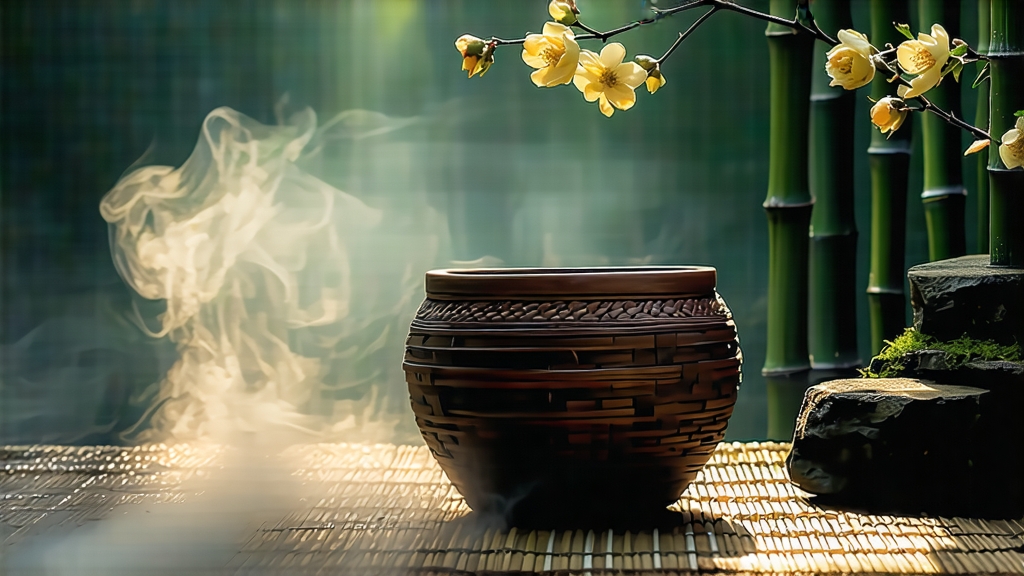
Tucked high above the Sichuan basin, where perpetual cloud veils the Min River gorge, lies Meng Ding Mountain, the cradle of the world’s oldest recorded tea garden. It was here, during the Tang dynasty (618-907 CE), that Buddhist monks first coaxed a faint golden hue from the downy tips of the local tea bush, creating what later Song-era poets called “the liquid sunrise.” The name Meng Ding Huang Ya—literally “Meng Summit Yellow Bud”—first appears in an imperial tribute list of 724 CE, when 360 cakes were dispatched to Chang’an along the Jianmen Road. For the next eleven centuries the tea remained an exclusive gift to the throne, so scarce that even palace annals mention it only on the occasion of major state rituals. When the last Qing emperor abdicated in 1912, the specialized craft of “sealed yellowing” almost vanished; only a handful of hereditary families on the northern slope kept the art alive by producing a few kilos for local pharmacists who valued its “cooling” properties. Today, after three decades of careful revival, Meng Ding Huang Ya is once again being plucked, but still in micro-batches—fewer than two thousand kilograms reach the global market each spring.
Botanically, the cultivar is a Camellia sinensis var. sinensis landrace locally known as “xiao ye zhong,” small-leaf Meng Ding. Its dormant buds accumulate an unusually high ratio of theanine to catechins, a balance that allows the slow oxidative “smothering” unique to yellow tea without collapsing into the grassiness of green tea. Growers recognize three grades: Ming-qian Imperial (pure bud, plucked before the Qingming festival), Rain-before Noble (one bud and one unfolding leaf, picked before Grain Rain), and Gu-yu Fine (one bud and two leaves). Each grade demands a dawn harvest when mountain mist is still heavy; sunlight quickly reddens the tender tips and ruins the subtle enzymatic choreography that follows.
The craft sequence—called “men huang” in Sichuan dialect—unfolds in five stages that stretch across three days and two nights. First, the freshly picked shoots are spread no thicker than one finger on bamboo trays and withered for ninety minutes in a shaded corridor where humidity hovers at 85 %. This brief wilting reduces surface moisture without activating the full oxidative cascade seen in oolong. Next comes the kill-green, but here the pan-firing temperature is kept 20 °C lower than for green tea—around 140 °C—and the leaves are hand-tossed for only four minutes, just enough to rupture cuticle cells and release aromatic precursors while preserving latent enzymes. The pivotal third step is the “wrapping” or “sealed yellowing.” The still-warm leaves are quickly piled in the center of a linen cloth, twisted into a loose bundle, and nestled inside a shallow cedar box. Every two hours the master unwraps, fluffs, and re-wraps the tea, monitoring the rise in core temperature (never allowed above 38 °C) and the gradual shift from grassy green to pale maize. This cycle continues through the night; by dawn the leaf edges have softened, and a faint scent of steamed pumpkin lingers in the air. On the second morning the bundles are opened and given a second, even gentler pan-firing to fix the color and arrest further oxidation. A final low-temperature bake at 60 °C for two hours reduces moisture to 5 %, ensuring shelf stability without sacrificing the velvety texture that defines the style.
Because the leaf is so young and the processing so delicate, Meng Ding Huang Ya rewards a brewing approach closer to white tea than to green. Begin with a tall, thin-walled glass or a porcelain gaiwan of 120 ml capacity; metal strainers bruise the downy tips and should be avoided. Use 3 g of leaf—roughly two heaping teaspoons—for each 120 ml of water at 80 °C. After pre-warming the vessel, pour the water in a slow spiral so that the buds rotate gently, releasing a faint orchid note within fifteen seconds. The first infusion should be decanted at the forty-second mark; subsequent steeps may be lengthened by ten seconds each time. A well-executed session yields five infusions: the first, pale champagne with a hint of sweet corn; the second, richer, like custard apple; the third, a return to lightness, echoing mountain spring water;